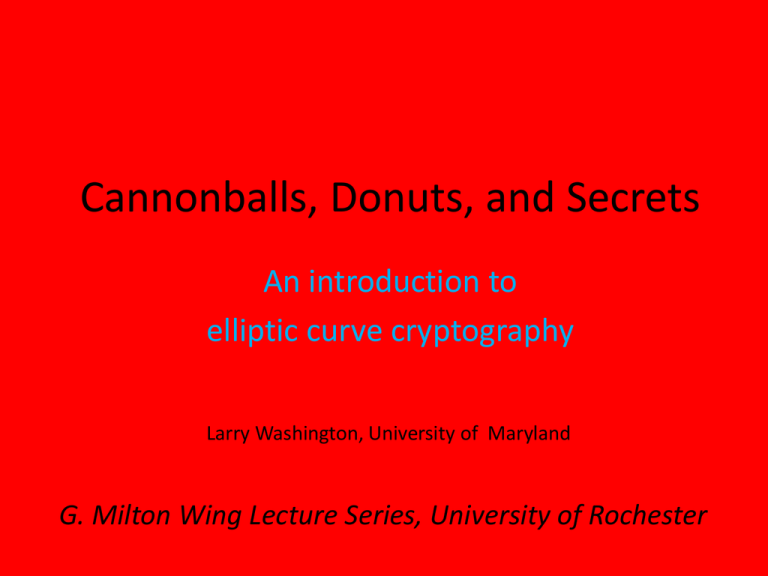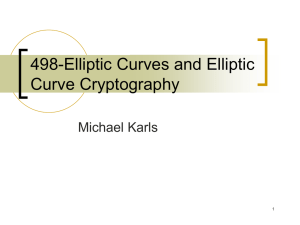power point slides - Mathematics
advertisement

Cannonballs, Donuts, and Secrets An introduction to elliptic curve cryptography Larry Washington, University of Maryland G. Milton Wing Lecture Series, University of Rochester A Pile of Cannonballs A Square of Cannonballs 1 4 9 . . . The number of cannonballs in x layers is 1 + 4 + 9 + . . . + x2 = x (x + 1) (2x + 1)/6 x=3: 1 + 4 + 9 = 3(4)(7)/6 = 14 If x layers of the pyramid yield a y by y square, we need y2 = 1 + 4 + 9 + . . . + x 2 y2 = x (x + 1) (2x + 1)/6 y2 = x (x + 1) (2x + 1)/6 y2 = x (x + 1) (2x + 1)/6 and y = x 2 1 + 4 + 9 + . . . + 24 = 702 Is there a right triangle with rational sides whose area is 5 ? a2 + b 2 = c 2 c b ab/2 = 5 a If we have a, b, c, let x-5 = Then ( ) a-b ___ 2 . Then x+5= 2 ( ) a+b ___ 2 2 x3 – 25x = x(x-5)(x+5) is a square. c 2 ___ and x = 2 ( ) We need points on the curve y2 = x3 – 25x with rational coordinates. (x, y) = (-4, 6) is a point on the curve. Draw the tangent line at this point. The intersection point has x = 1681/144 = (41/12)2 41/6 3/2 20/3 We can use the tangent line at this new point and find another triangle: 3344161/747348 4920/1519 1519/492 An elliptic curve is the graph of an equation y2 = cubic polynomial in x For example, y2 = x3 – 5x + 12 Start with P1. We get P2. Using P1 and P2, we get P3. Using P1 and P3, we get P4. We get points P1, P2, P3, . . . , Pn , . . . Useful facts: If we take the line through Pm and Pn and reflect the third point of intersection across the y-axis, we get Pn+m If we start with P1 , after m steps we get Pm If we start with Pm , after n steps we get Pmn All of these calculations are done mod a big prime. Otherwise, the computer overflows. Given n , it is easy to compute Pn (even when n is a 1000-digit number) Given Pn , it is very difficult to figure out the value of n . Is this good for anything? There is no branch of mathematics, however abstract, which may not someday be applied to the phenomena of the real world. —Nikolai Lobachevsky (1792-1856) “Do you know the secret?” The Eavesdropper The secret is a 200-digit integer s. Prove to me that you know the secret. I send you a random point P1. You compute PS and send it back to me. If your answer is correct, I decide that you know the secret. Diffie – Hellman Key Establishment Alice and Bob want to agree on a key for use in a cryptosystem. 1. They choose an elliptic curve and a point P1 on the curve. 2. Alice chooses a secret integer a and Bob chooses a secret integer b. 3. Alice computes Pa and Bob computes Pb. They exchange Pa and Pb. 4. Alice does a steps starting with Pb and computes Pba , and Bob computes Pab 5. They use the coordinates of Pab to construct the desired key. Lived from ?? to ?? Probably about 1800 years ago. Diophantus passed one sixth of his life in childhood, one twelfth in youth, and one seventh as a bachelor. Five years after his marriage was born a son who died four years before his father, at half his father’s age. How many years did Diophantus live? Diophantus passed one sixth of his life in childhood, one twelfth in youth, and one seventh as a bachelor. Five years after his marriage was born a son who died four years before his father, at half his father’s age. How many years did Diophantus live? To divide a given number into two having given difference. Given number 100, Given difference 40. Lesser number is x. Larger is x + 40. Therefore 2x+40 = 100 x = 30 The required numbers are 70, 30. KYb DYgisMd 2x3 – 3x2 = 4 saisMb x=2 ib iz fib a Sxle 17 12 1 512 35 x DYie MlV en moriw DYDaMlV (15 x2 – 36)/(x4 + 36 – 12 x2) DYib +, = x . > a2, a3, a4, … aa, a3, a4, … 1489 1557 1620 1600 1600 1634 1637 (Descartes) Diophantus’s goal: Given a solution of an equation, find another solution. Given a point on a curve, find another point. Using P1 and P3, we get P4. Problem: Find rational x and y such that x2 + y2 =1. We know the easy solution x=1, y=0. Draw the line through this point with slope, say, -2. The second point of intersection gives a new point, in this case x= 3/5, y=4/5. What happens if we try higher degree curves? y2 = x5 – 7x3 + 6x +17 Faltings’s Theorem (1983): A higher degree curve (technically: genus > 1) has only a finite number of points with rational coordinates. What about the donuts? y2 = x (x + 1) (2x + 1)/6 y2 = x5 – 7x3 + 6x +17











